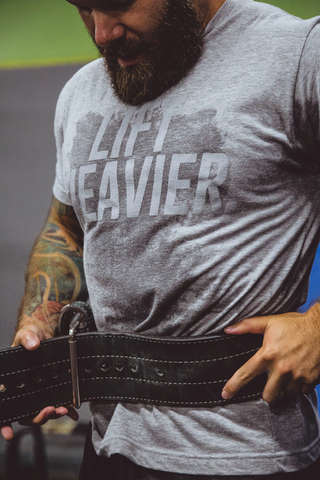7 DEADLIFT COMMANDMENTS
Thou shall maintain a vertical bar path directly above your mid foot.
WHY? The most efficient way to pull a barbell is straight up. Begin with the bar mid-foot, approximately 1” from your shin, with shoulders inline above, or just slightly forward. Respect the following commandments as well and eliminate any unnecessary gravity advantages.
Thou shall brace correctly.
WHY? Safe Gains. Fill your belly up with air, brace the core muscles against it, and prohibit it’s release. A good cue here is to push your tongue to the roof of your mouth to create a seal. Imagine for a moment preparing to be kicked by a donkey, in the midsection. Assume that feeling of preparation, using your natural belt as best and often as you possibly can. When bracing in this manner, combined with your lat engagement, you will increase your ability to lift heavier while maintain core stability. This will lead to greater strength overall.
Thou shall FLEX on them, your lats that is.

WHY? The lats play a pivotal role in deadlift performance. Doing so correctly will shorten the distance between the arms and the hips. A study by Greg Nuckols, which you can find at Stronger By Science, explains this in intense detail. Long story short, if the lats are not engaged, the barbell will often drift out of it’s vertical path, lengthening the pull and increasing the stress on the lower back and hips. To flex your lats, pull your elbows into your body, squeezing your shoulder blades back. A solid training technique is light forward band assistance, which will force you to engage your lats in order to maintain a bar path near your body.
Thou shall pull the slack out.
WHY? Certainly, the deadlift is so great because of it’s simplicity. However, it is not a grip and rip function, as dope as that sounds. Eliminating the slack syncs your body, the floor, and the barbell; this establishes a relationship creating tension allowing one to lift safely and efficiently. It is important to know that this act will not always be visible to bystanders, unless you are pulling large load. Still, the importance is the same, and the process should not be dependent on load. Consider it a primer for your body.
Thou shall push the floor away.
WHY? It will help you maintain stability and form while adding additional force to your pull. The deadlift is a pulling exercise, but one of the most phenomenal cues you can have in your arsenal, is the focus of pushing the floor away to begin you lift. It is almost an afterthought that we use our legs when deadlifting, which is why this is an incredible concept. Initiating a mind/muscle connection involving your legs as a pushing mechanism, and not just stability for the pull, creates more force applied to your overall effort. Other focus cues is to imagine using a leg press, or pushing your legs into the earth.
Thou shall engage your hips at the correct time.
WHY? This done correctly is important, not only for improved performance, but for injury prevention. After following the previously mentioned cues (setup mid-foot, bracing, lat engagement, and driving the floor away), the moment for the mighty hip hinge arrives; as you know, the deadlift is a hip dominant movement. When the barbell reaches your knees (after you have pushed the floor down!), flex your glutes, and drive your hips forward to the bar. DO NOT pull the bar to your hips. If you are pulling weight that is too heavy, your back may round to move your hips closer to the bar for what feels like a better mechanical advantage. When this happens, you will look exactly like a dog taking a sh*t, and possibly immortalized in a meme. If it feels like you are going to gain leverage by doing so, it may be time to check your EGO, and take a step back. You can find more in our 5 Common Deadlfting Mistakes You're Making.

Thou shall do speed and form work at lower intensity, and add variety.
WHY? As exciting and hype it is to conventional pull at 90-100 percent of your one rep max every single deadlift, it is not safe or beneficial. Lower intensity with strict focus will create good habits, and good form. Deadlift work does not mean heavy work without a purpose! Also, enjoy a plan that involves other variations such as sumo (yes, sumo), squat, axel, hex bar, deficits, and block pulls. Enjoy the plethora of options to see what works best for you, and to keep your deadlift training sessions fresh, inventive, and purposeful.



KovWsSIlQwHDe
Leave a comment